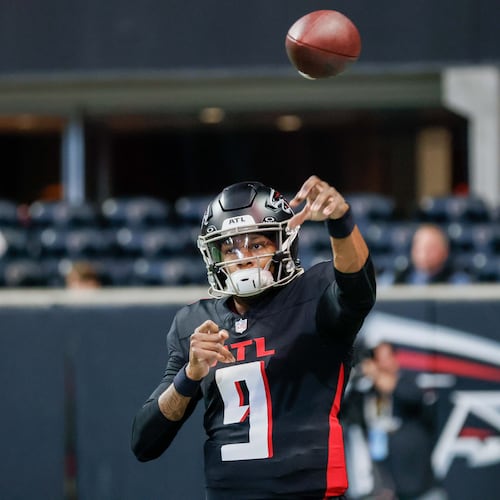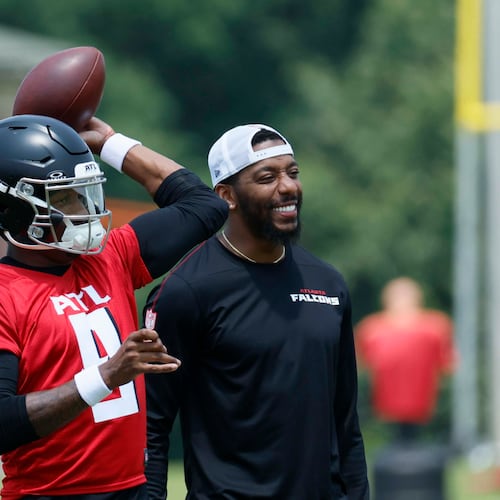Mark Richt said he hadn’t thought about the issue and didn’t want to distract from his attention during a game week, never mind that Georgia’s opponent was 42-point underdog Charleston Southern, an FCS sacrifice.
Paul Johnson said he didn’t have an opinion on the subject. It’s believed to be the first time the Georgia Tech coach didn’t have an opinion on something.
Rich McKay, the Falcons’ president and long-time NFL competition committee member, could not be reached for his no-comment. All week. He’s a veteran. If there were degrees on knowing when to go stealth, McKay would hold a Ph.D.
What would be considered so sensitive as to cause mass avoidance? The potential ripple effect of seeing an NFL-ready junior, Georgia’s Todd Gurley, on the ground last week with a season-ending knee injury.
Most believe Gurley was physically developed enough to turn pro last season. But he wasn’t eligible for the draft because he was only two years out of high school, one less than the NFL requirement. But after suffering a torn knee ligament against Auburn, the tailback is expected to drop from a potential top-10 pick to possibly into the second round.
Georgia recently doubled Gurley’s disability coverage to up to $10 million ($5 million for “loss of value”). But that won’t nearly make up for his lost guaranteed salary in his rookie contract, which likely will drop from $12 million-plus to possibly $2 million guaranteed.
The injury has reignited the debate over whether the draft age should be lowered.
It should. In no other sport must college athletes wait three years to compete as professionals. Baseball and hockey players can be drafted out of high school, basketball players after their college freshman year.
Two years ago, South Carolina running back Marcus Lattimore, a projected first-round pick, suffered a catastrophic knee injury as a junior. He was drafted by San Francisco, but never fully recovered and retired last week. Former South Carolina defensive end Jadeveon Clowney might’ve been the first pick in the draft following his sophomore season, but was forced to wait.
Renowned sports agent Pat Dye Jr., son of the former legendary Auburn football coach and Lattimore’s agent, concedes that the junior-eligibility rule “has merit for probably 95 percent of the players.” But he said the fact there’s a select group of potential stars annually, combined with the shifting landscape in college athletics, makes this time “ripe for change.”
“I know this is a sensitive subject, as the son of a college Hall of Fame coach,” Dye said. “If Bo Jackson chose to come out before his senior year, I would’ve been crushed by it. But I’ve been in this business 27 years, and I’ve seen the violence of the collisions and the way the financial dynamics have changed. I went to college to get an education and a job. I didn’t go for the fun and the experience. I didn’t go for the parties. At the end of the day, Clowney knows where he’s going to get a job. If IBM or Apple wanted to hire some kid after his freshman year at Stanford, he could do whatever he wants.”
NFL draft rules are part of the Collective Bargaining Agreement. But the league has a cozy relationship with college coaches. The Nick Sabans of the world want to keep players for as long as possible. College football provides the NFL with a relative free minor league system. League personnel directors are given access to practices and game tape. The NFL would rather not rock that boat.
But the NCAA is scrambling. Class-actions suits and athletes’ threats to unionize are prompting change. Scholarship values are increasing. The NCAA could view lowering the draft age as a concession to college athletes, which would open the door to the NFL.
“If that happened, I don’t believe the NFL would resist change,” Dye said.
Ralph Cindrich, another long-time agent and a former NFL player, agrees. He expects a change in the next few years.
The rules were “set up for business, not for the health and welfare of players,” Cindrich said. “What right does the NFL or the NCAA have to prevent an individual from working?”
Punctuation: “The NCAA has proven its motives are corrupt.”
There was angst when the NFL first allowed juniors to enter the draft in 1989. Football officials contend sophomores aren’t developed enough for the NFL. In general, they’re correct, particularly linemen. But there’s an increasing pool of young skill players — running backs, receivers, cornerbacks — because of improved training and nutrition programs.
Notre Dame coach Brian Kelly said he is hesitant to “paint with a broad brush. It’s a difficult decision to make in this sport, compared to basketball, for example, because you’re dealing with a different skill set at different positions.”
A rules change could prompt too many underclassmen to declare for the draft. In 1989, 165 underclassmen applied and 76 went undrafted. The NFL instituted a policy where players could get a pre-draft “grade” from the league without compromising their NCAA eligibility, but they still have to finalize their decision by mid-January, before the combine. Last year, 45 of 107 declared underclassmen were undrafted.
College coaches would oppose the January deadline changing because they need clarity before national signing day. So there’s a myriad of issues.
But how could anybody see Gurley leaving Sanford Stadium via ambulance and not believe change is coming?
Bulldogs linebacker Amarlo Herrera believes the rule is “about right.” His teammate, wide receiver Michael Bennett, disagrees.
“If you feel you’re ready to, I feel you should definitely have the opportunity to go and make money,” Bennett said. “I don’t know if Todd would have done that or not. But I feel like he is NFL-ready. I think he was ready the day he stepped on campus. It’s a shame he didn’t have that option.”
Before Gurley’s injury, Dye said he was told by some teams that the 20-year-old “might be the best player in the draft.”
Unfortunately, he won’t be turning pro with that same immediate potential. Something is wrong with that.
About the Author
Keep Reading
The Latest
Featured


